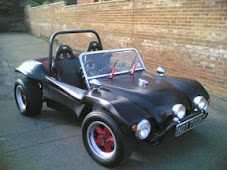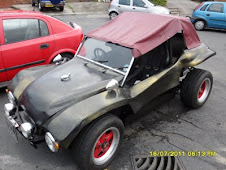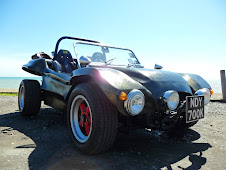16th May 2019
 After rebuilding my carbs I felt it would be a good idea to check to see if they were still tuned. This process requires a Snail synchrometer / flow meter pictured left available for about £33.00 GDP currently at the time of writing this article.
After rebuilding my carbs I felt it would be a good idea to check to see if they were still tuned. This process requires a Snail synchrometer / flow meter pictured left available for about £33.00 GDP currently at the time of writing this article.First of all this procedure relies on the linkage kit connecting the carburetors together to be removed from connecting to the throttle arms. It also is only good if your carburetors have been previously balanced. You should check that the adjuster to open the butterflies is set to same distance on both carburetors. Once this has been achieved you can use the synchrometer / flow meter in the top of the carbs turret/ horns over cylinders two and three. They should be pulling about eight pounds of air at idle. This should be the same on both cylinders and the idle regulator can be adjusted on the lower carburetor to open the butterfly further and bring up the same air flow in each carburetor.
Basic Procedure to get you running.
The next procedure is to adjust the idle mixture screw until the engine starts to falter. Turn it in until you detect a misfire and then turn it back until the miss fire stops and then unscrew the idle mixture screw a further quarter turn back. This has then to be done on each of the four barrels to complete the procedure.
Carburetor balancing.
One of the most important aspects of tuning the Dellorto DRLA series carburetors is to ensure that the carburetor barrels are all balanced. Synchronising the carburettors consists of adjusting the flow of fuel-air mixture through each barrel so that it is exactly the same as each each of the others. If you are following the basic procedure it is most likely that you have no Idle Air Bypass Screw which is used to assist in balance air flow through carburetors barrels. It is not guaranteed that your Dellortos will have this factory fitted. My own carburetors came from an Alfa Romeo part DRLA 40 06256 D 0605-150590 came from a 1.7 Quaduri foglio Alfa 33. They was covered by a small silver aluminium disk which had to be removed to give access to the screw. They can get very blocked under this cover and in need of attention. The procedure to set the carbs up is very basic . You wind the screws in clockwise until they are all just seated on each barrel and check the flow level in each of two barrels usually 2 & 4 then check them against 1 & 2 adjusting the screws out for any variance in flow on the meter.
Many people have asked over the years how the jetting is calculated . There is a set of basic principles for these calculations. A useful formula for the calculation of main jet size when the maximum venturi is known is to multiply the venturi by 4 (according to the Dell book) 4.2 or 4.3 in practice as the smaller venturi on smaller engines. This will give a starting point for the main jet size which should be 'safe'.
MAIN JET SIZE = VENTURI SIZE x 4 (+1 N.B if available)
AIR CORRECTOR = MAIN JET + 50
Using these formulas for a 28 mm choke/ venturi would give a Main Jet of 112 and an Air Corrector jet size of 175.
 Therefore you can work out exactly what parts you require for your engine running at a given RPM as follows:
Therefore you can work out exactly what parts you require for your engine running at a given RPM as follows:It can be seen that a 1641cc engine would require a 28 mm Venturi/Choke 112 Mains and Air Corrector Jet of 175. This jet is very good for a standard jet but for high rev ranges the 115 is a better choice when used with a 180 Air corrector. Which gives better fuel delivery at high rpm unlike the 112. which also gives sportier performance in smaller engines.
Idle Jets can become confusing as the name suggests that they govern the idle mixture, this is incorrect. It is true that fuel is consumed through the idle jet but it is not metered by these jets, but the volume idle screws mounted on each barrel of the carburetor. These jets control the progression between closed throttle and the main jet supply and is necessary for smooth acceleration when driving.
Engine Size Idle Jets
CC Jet
1600 55/60
1800 ...
2000 ...
It should be noted that Dellorto jets are flow tested and every jet is produced to give a standard flow. This means in practice that unlike numbered jets two jets with the same number are standardized with no variance.
Selection of Idle Jet is a difficult process and usually can be selected as an approximation which works when the car is driven. If the car nose dives then a change can be achieved by changing the Idle Air Jet holder 10738 his alters the amount of air emulsified through the jet 7210. If you have changed through all of the Idle Air Jet Holders without improvement of which there is ten (10) in total then you should consider increasing the jet size and repeating the procedures. It should be noted Idle is dependent on intake valve size. 1.5*intake valve=base idle = 900.
Idle Jet | Leaner | Normal | Rich
7210 |.5 .10 .9 | .1 .3 .6 | .7 .2 .8
We are told the reason for this strange order by eurocarb is that the emulsion tubes where originally created on request without the order toy would expect.
Starter Emulsion Tubes and Starter Jets.
The DRLA Starter Emulsion tubes are numbered 7482.1 to 7482.4. The Starter Jets are numbered 3315.xx and have the range (48-105). There is a Samba article that states these are for cold start only with chokes. However my DRLA 40 are fitted with mechanical choke and I have read many articles saying leave them in situ. However leaving them blank is not an option as it will change the required jests and emulsion tubes making the tubes narrower and the jets richer. eurocarb in the UK sell cover which allows you to keep the same jets as you have with the mechanical chokes They have a data sheet that is standardized across the engines using the 7482.3 emulsion tube with a 80 starter jet in the UK with leaded fuel . 95 RON the Unleaded standard requires a 95 Jet. The jet range other than this was used on motorcycles as main jet which explains the requirements for the wider range of jets.
Before you attempt to change any settings.
Tuning an engine the first time.
Before starting to tune any engine you have to ensure all services are functioning .This includes electrics/ tappets and distributor advance.
Start with an idle speed of around 900 rpm Screw the idle screws home and then out 2.5 turns. Let the engine build temperature and fully warm up. Using the air volume flow meter to check the flow of air front to back on carburetor one side. If the rear barrel is pulling in less air. . Then turn the mixture screw on this barrel clockwise to make it the same air flow as the front. If the idle speed increases from 900 rpm then back off the throttle stop screw until it is at 900 rpm again. This must be repeated for both carburetors to ensure the flow is the same.
Only at this point can you proceed when you are sure each barrel is pulling the same volume of air.
Start to back off one of the mixture screws a quarter of a turn at a time allowing a few mins for the engine to settle after each small adjustment. Note if the engine increases or decreases RPM If the RPM goes up then use the throttle stop screw to bring it back down to 900 rpm. if the RPM falters then turn the idle screw back counter clockwise 1/4 turn readjust to 900 rpm. Repeat for all barrels. This should give a smooth idle . If this is not possible check the linkages or spindles.
All prices as of 2019.
























